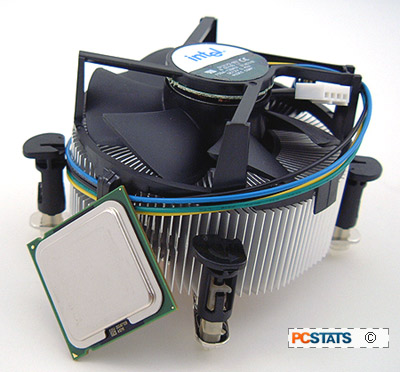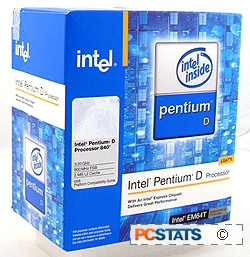 The Intel Pentium D 840 performed well
in the office and rendering benchmarks, but comparatively less so on the pure
number crunching and gaming tests. Any benchmark that involved multi-threading
or multitasking allowed the processor to flex its muscles, increasing scores
considerably over its single-core equivalent.
The Intel Pentium D 840 performed well
in the office and rendering benchmarks, but comparatively less so on the pure
number crunching and gaming tests. Any benchmark that involved multi-threading
or multitasking allowed the processor to flex its muscles, increasing scores
considerably over its single-core equivalent.
We were pleasantly surprised to get an 820MHz overclock
out of the Intel Pentium D 840 on air cooling. Given that the processor is using
a brand-new chipset for testing, this is not bad at all.
In some respects, pitting the Intel Pentium D 840
against the AMD Athlon64 X2 4800+ is not a fair match up. While both processors
are at the top of their respective lines, the Athlon64 X2 4800+ costs almost
double the price of the Intel CPU. It's not surprising that the AMD dual-core
chip is faster at gaming and mathematical operations either, since single-core
Athlon64 processors enjoy the same advantages over Intel Pentium 4 chips.
It comes down to economics in the end. For a business
that needs multi-tasking, multi-threading capabilities, the Pentium D 840 may be
the better buy where sheer cost is the primary concern. For an application that
needs maximum single and dual-core performance regardless of costs, the AMD
Athlon64 X2 4800+ comes out on top. For the home user that just wants to play
games fast, neither processor is ideal, one being too pricey, the other slower
than comparably priced single-core chips.
One interesting fact we noted with both Intel and AMD dual-core
processors is that the amount of reported memory bandwidth was lower than their
single-core equivalents. We'd hypothesize that this is because of the inherent
overhead of communication between the two cores on the die.  The Intel Pentium D 840 also
needs to use the FSB to transfer data between cores, so this would be an obvious
possible area of slowdown. Of course, it could also be that the 955X Express
platform we tested the Pentium D 840 on is still immature. The effect of
internal memory speed on Pentium D performance is quite noticeable, as we
mentioned earlier in the review.
The Intel Pentium D 840 also
needs to use the FSB to transfer data between cores, so this would be an obvious
possible area of slowdown. Of course, it could also be that the 955X Express
platform we tested the Pentium D 840 on is still immature. The effect of
internal memory speed on Pentium D performance is quite noticeable, as we
mentioned earlier in the review.
The Intel Pentium D 840 has taught us one
now-indisputable fact about the nature of dual-core CPUs: Just because it has
two cores doesn't mean it's going to be faster at everything... But now we're
being unreasonable.
The Intel Pentium D 840 behaved exactly as you would expect
a processor made of two standard 3.2GHz Prescott Pentium 4 cores to do. It
excelled on any and all benchmarks which involved multi-tasking or
multi-threading, and otherwise performed exactly like a single-core Intel
Pentium 4 3.2GHz processor.
Given that Intel has not priced the Pentium D line of
processors above faster single core chips, loyal Intel users are faced with a
fairly simple choice: If the things that you do with your computer everyday
involve multi-tasking or multi-threaded applications, a dual-core Pentium D
processor will give you the most bang for your buck. If you primarily play
games, do not engage in heavy multi-tasking or do not use multi-threaded
applications, a single-core Pentium 4 processor clocked faster than 3.2GHz will
give you better performance every time.
Find out
about this and many other reviews by joining the Weekly PCstats.com Newsletter
today! Once again, PCSTATS would like to thank Ivan Woo of DAIWA Distribution for helping to facilitate this review.
Related Articles
Here are
a few other articles that you might enjoy as well...
1. Intel Pentium 4 3.2E GHz Prescott Processor Review
2. Intel Pentium 4 3.2GHz Extreme Edition
Processor Review
